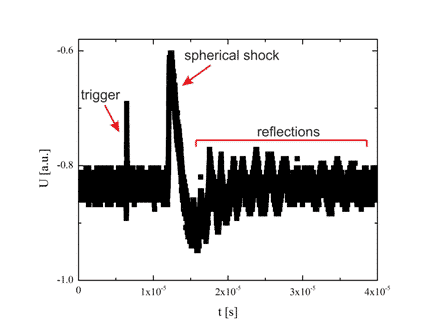Shock wave propagation in capillary is investigated experimentally. The shock waves are generated by a high speed magnetic valve or high power lasers, respectively. In contrast to the conventional methods of shock wave generation in macroscopic scale, the valve or laser generated shock waves in the capillary enables the investigation to happen in the submillimeter towards the micrometer scale.
In the first part of the experiments, a high speed magnetic valve is applied for the generation of shock waves in a capillary with 0.5 mm diameter. We investigate different gases with supersonic and low Renolds-number flows to get information about the friction influence and the choke distance. Preliminary results can be seen in Figure 1.
Figure 1: High speed valve generated shock waves; 20 bar back pressure, nitro-gen as driver gas; the 0.5 mm capillary is pumped to di�erent initial pressure before shock waves are generated.
In the second part of the experiments, through an optical breakdown in air induced by a fs-laser (Ti:Sapphire, Clark-MXR) or a ns-laser (Nd:YAG) respectively, initial spherical shock waves are generated in a glass capillary (diameter of 0.75 mm or 0.5 mm).
It is well known that in the investigations of shock waves in free air, the initial shock wave will be decelerated to sound speed after propagating through a distance of several millimeters. The reason of this deceleration is the fast pressure reduction, which is the consequence of the spherical propagation geometry.
Figure 2: Illustration of the shock waves propagation in capillary and the experimental setup.
In contrast to the free air, in a capillary the initial spherical shock wave is still strong after propagating several millimeters, furthermore it becomes quasi plane wave and it is accompanied by a complicated pattern of reflections. Figure 2 shows that the propagation in x-direction (radial direction) is confined by the diameter of the capillary. Therefore the initial spherical shock wave is reflected on the inner wall of the capillary. After that, the reflected pressure waves interfere with each other in the axis area of the capillary, thus they are reflected/transmitted again. These reflections repeat periodically along the capillary axis. By means of a laser differential interferometry (LDI), we are able to determine the shock wave velocity in z-direction (the axis direction of the capillary) and investigate the periodic density changes resulted from the reflections. The oscillogram in Figure 3 presents a fs-laser induced shock wave. The oscillogram in Figure 4 presents ns-laser induced not-fully-developed shock wave (top) and the quasi plane wave with a plateau (bottom). Laser-induced breakdown in different solid state targets (e.g. Al thin film of about 50 nm) instead of air are also under investigation. Our preliminary experiments have shown that strong shock waves can be generated in this way and further interesting results are to be presented.

Figure 3: Oscillogram, initial spherical shock wave as the major peak and refections as smaller periodical peaks, fs-laser, 0.75 mm capillary.
Figure 4: Oscillogram, ns-laser induced shock waves, 0.75 mm capillary; top: initial spherical shock wave, 12 mm away from breakdown site; bottom: quasi plane wave, 110 mm away from breakdown site.

